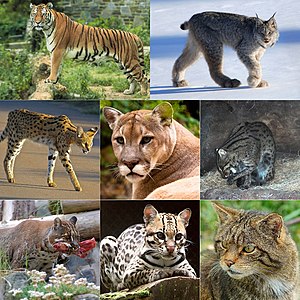Panthera is a genus within the family Felidae, it is one of two extant genera in the subfamily Pantherinae, and contains the largest living members of the cat family. There are 5 living species, the tiger, jaguar, lion, leopard and snow leopard and a number of extinct species.
The term "big cat" is typically used to refer to any of the five living members of the genus Panthera, namely the tiger, lion, jaguar, leopard, and snow leopard, as well as the non-pantherine cheetah and cougar.

Pseudaelurus is a prehistoric cat that lived in Europe, Asia and North America in the Miocene between approximately twenty and eight million years ago. It is considered to be a paraphyletic grade ancestral to living felines and pantherines as well as the extinct machairodonts (saber-tooths), and is a successor to Proailurus. It originated from Eurasia and was the first cat to reach North America, when it entered the continent at about 18.5 Ma ending a 'cat-gap' of 7 million years. The slender proportions of the animal, together with its short, viverrid-like legs, suggest that it may have been an agile climber of trees.

Felis is a genus of small and medium-sized cat species native to most of Africa and south of 60° latitude in Europe and Asia to Indochina. The genus includes the domestic cat. The smallest Felis species is the black-footed cat with a head and body length from 38 to 42 cm. The largest is the jungle cat with a head and body length from 62 to 76 cm.

The African golden cat is a wild cat endemic to the rainforests of West and Central Africa. It is threatened due to deforestation and bushmeat hunting and listed as Vulnerable on the IUCN Red List. It is a close relative of both the caracal and the serval. Previously, it was placed in the genus Profelis. Its body size ranges from 61 to 101 cm with a 16 to 46 cm long tail.
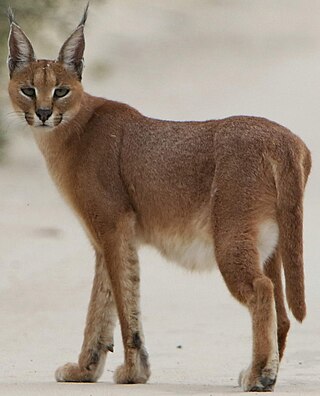
The caracal is a medium-sized wild cat native to Africa, the Middle East, Central Asia, and arid areas of Pakistan and northwestern India. It is characterised by a robust build, long legs, a short face, long tufted ears, relatively short tail, and long canine teeth. Its coat is uniformly reddish tan or sandy, while the ventral parts are lighter with small reddish markings. It reaches 40–50 cm (16–20 in) at the shoulder and weighs 8–19 kg (18–42 lb). It was first scientifically described by German naturalist Johann Christian Daniel von Schreber in 1776. Three subspecies are recognised.

The leopard cat is a small wild cat native to continental South, Southeast, and East Asia. Since 2002 it has been listed as Least Concern on the IUCN Red List as it is widely distributed although threatened by habitat loss and hunting in parts of its range.

Prionailurus is a genus of spotted, small wild cats native to Asia. Forests are their preferred habitat; they feed on small mammals, reptiles and birds, and occasionally aquatic wildlife.

Panthera atrox, better known as the American lion, also called the North American lion, or American cave lion, is an extinct pantherine cat. Panthera atrox lived in North America during the Pleistocene epoch, from around 340,000 to 12,800 years ago. The species was initially described by American paleontologist Joseph Leidy in 1853 based on a fragmentary mandible (jawbone) from Mississippi; the species name ('atrox') means "savage" or "cruel". The status of the species is debated, with some mammalogists and paleontologists considering it a distinct species or a subspecies of Panthera leo, which contains living lions. However, novel genetic evidence has shown that it is instead a distinct species derived from the Eurasian cave or steppe lion, evolving after its geographic isolation in North America. Its fossils have been excavated from Alaska to Mexico. It was about 25% larger than the modern lion, making it one of the largest known felids.
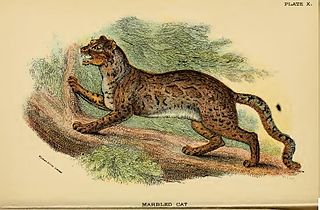
Pardofelis is a genus of the cat family Felidae. This genus is defined as including one species native to Southeast Asia: the marbled cat. Two other species, formerly classified to this genus, now belong to the genus Catopuma.
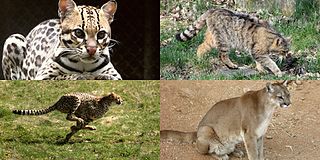
Felinae is a subfamily of the Felidae and comprises the small cats having a bony hyoid, because of which they are able to purr but not roar. Other authors have proposed an alternative definition for this subfamily, as comprising only the living conical-toothed cat genera with two tribes, the Felini and Pantherini, and excluding the extinct sabre-toothed Machairodontinae.

Leopardus is a genus comprising eight species of small cats native to the Americas. This genus is considered the oldest branch of a genetic lineage of small cats in the Americas whose common ancestor crossed the Bering land bridge from Asia to North America in the late Miocene.

The Pantherinae is a subfamily of the Felidae; it was named and first described by Reginald Innes Pocock in 1917 as only including the Panthera species. The Pantherinae genetically diverged from a common ancestor between 9.32 to 4.47 million years ago and 10.67 to 3.76 million years ago.

The African wildcat is a small wildcat species with sandy grey fur, pale vertical stripes on the sides and around the face. It is native to Africa, West and Central Asia, and is distributed to Rajasthan in India and Xinjiang in China. It inhabits a broad variety of landscapes ranging from deserts to savannas, shrublands and grasslands.

Pristifelis is an extinct genus of feline from the late Miocene. It contains a single species, Pristifelis attica. The first fossil skull of P. attica was excavated near Pikermi in Attica, Greece. Fossils were also excavated near the Moldovan city of Taraclia. It was also discovered in Maragheh, northwestern Iran. P. attica was bigger in body size than a European wildcat but probably smaller than a serval. The species was first described as Felis attica by Johann Andreas Wagner in 1857. Due to size differences, it was proposed as type species for the genus Pristifelis proposed in 2012.

Panthera blytheae is an extinct species of pantherine felid that lived during the late Messinian to early Zanclean ages approximately 5.95–4.1 million years ago.The first fossils were excavated in August 2010 in the Zanda Basin located in the Ngari Prefecture on the Tibetan Plateau; they were described and named in 2014.

Caracal is a genus in the subfamily Felinae of the family Felidae. It was proposed by John Edward Gray in 1843 who described a skin from the Cape of Good Hope in the collection of the Natural History Museum, London. Historically, it was considered to be a monotypic genus, consisting of only the type species: the caracal C. caracal.
Miopanthera is an extinct genus of Pseudaelurus-grade felids.
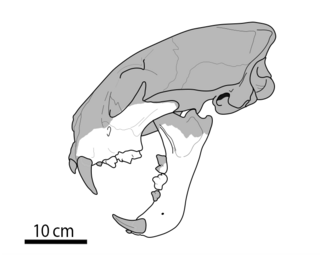
Pachypanthera is an extinct genus of pantherine felid that was recovered from the Late Miocene-aged Khorat sand pits in northeastern Thailand. It contains a single species, Pachypanthera piriyai, named and described in 2023.
